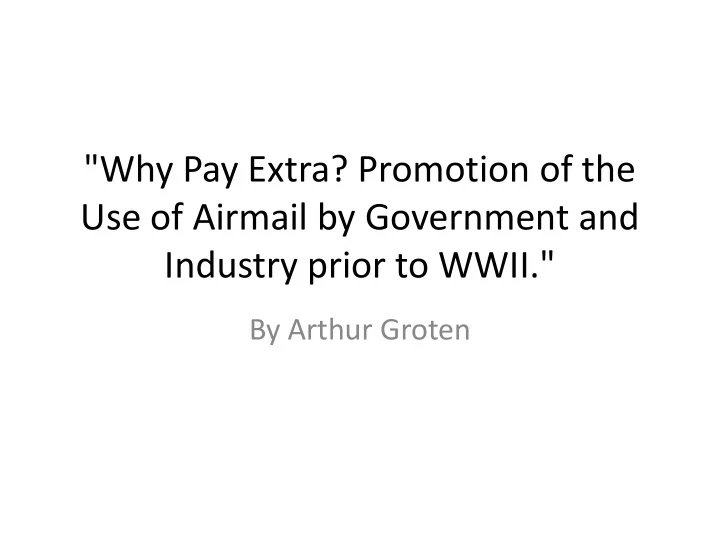

"Why Pay Extra? Promotion of the Use of Airmail by Government and Industry prior to WWII." By Arthur Groten
I. The Earliest Days Earle Ovington at Bleriot’s flying school in Pau, France. The poster stamp for the school is on the back of the photograph.
Ovington in Glenn Curtiss’s bi-plane at the 1911 Chicago International Air meet.
Ovington took this photo of the Garden City Aerodrome from his Bleriot.
Ovington’s personal copy of his appointment as the first official U.S. airmail pilot.
The St. Louis Post ran this photo of Ovington receiving the first bag of official airmail on 9/23/11.
PMG Hitchcock handed the mailbag to Ovington on 9/25.
Doubleday, Page & Co., publishers in Garden City, foresaw the importance of these demonstration flights.
The first regularly scheduled route, between Washington and New York, commenced on May 15, 1918. Ovington wrote to his wife about it.
The USPOD reports the commencement of New York to Chicago route.
II. Federal Government Promotion 1928 Michigan schedule
1928 New York schedule with general airmail information.
1926 Chicago brochure
The Chicago postmaster took ads in local playbills to promote airmail service.
Cards issued by the Moline, IL postmaster for distribution to his clients.
Secretary of State Herbert Hoover paid the air fee rather than use his free franking privilege.
This stereo view card of an air mail plane notes, on the reverse, the 10¢ rate.
American Airlines blotter announcing the new 5¢ rate.
USPOD leaflet explaining the new rate structure.
Air mail etiquettes often note the current rate.
USPOD air etiquette booklets promoted the new 6¢ rate
Other etiquettes promoted the speed of air mail.
Many cities used these machine cancels: “Air Mail Saves Time.”
The method of carriage was at the discretion of the postmaster. Thus the request for “whichever is quickest.” It wasn’t always air mail.
The hand stamps on these covers attest to the postmaster’s discretion.
Sometimes the quickest wasn’t the safest.
III. Special Events and other quasi-official promotion Lindbergh was a major promoter of the use of air mail after his historic 1927 flight.
Private entrepreneurs offered to build airports for smaller towns.
Special conferences on establishing airports were held around the country.
Curtiss-Wright’s headquarters were at the Grand Central Air Terminal in Glendale, CA in 1931.
Oakland [CA] municipal airport issued a self-mailing 14-page brochure on their services in 1928.
Many of these cards were produced by cities around the country to announce their new air services.
Commercial air events were very popular in the inter-war years. Poster stamps were often used to promote them.
In addition, there were air meets that often included air races.
Prior to the 1938 National Air Mail Week, local Air Weeks were held as at Miami in 1929.
An unusual USPOD mimeographed cachet for National Air Mail Week, 1938.
A variety of unusual events were staged to celebrate NAMW.
Hal Burnett, of WBBM, Chicago, sending off his round-the-world record disk.
Initial press release for Burnett’s plan.
IV. Private and Airline Promotion Hand stamps were the simplest form of private advocacy.
A beautiful meter slogan, clearly promoting air travel.
Air mail stationery began as hand- drawn. Preprinted envelopes show a myriad of designs.
The folding Airgram was first introduced by Varney in 1927.
In addition to the USPOD etiquettes, there were many private ones.
Hotels often prepared special air etiquettes for their patrons.
Airlines promoted their services with air etiquettes as well as air baggage labels.
Notes that some even refer to their particular route designation.
And, of course, there were leaflets and brochures as well.
The promotional activity was demonstrably successful.
Recommend
More recommend